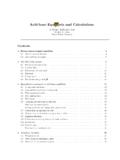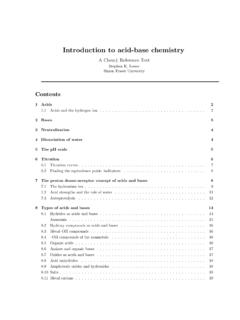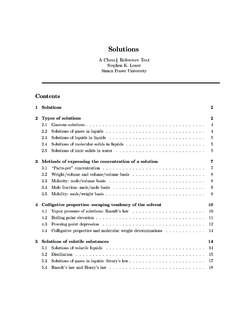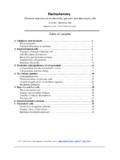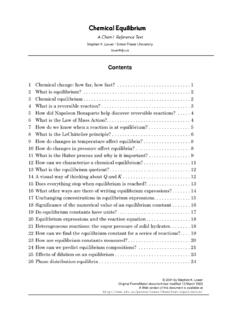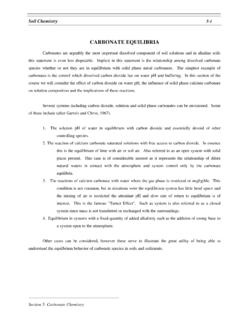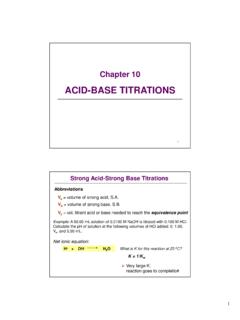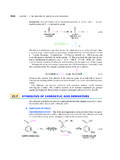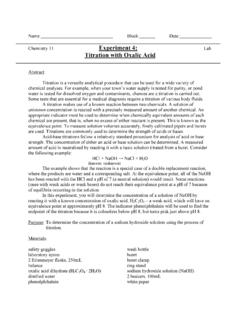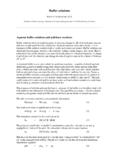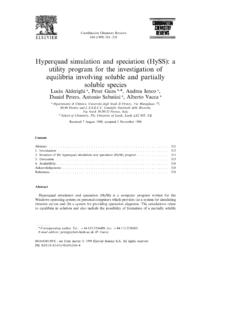Transcription of Carbonate equilibria in natural waters - Chem1
1 Carbonate equilibria in natural watersA Chem1 Reference TextStephen K. LowerSimon Fraser UniversityContents1 Carbon dioxide in the atmosphere32 The Carbonate system in aqueous Carbon dioxide in aqueous Solution of carbon dioxide in pure Solution of NaHCO3in pure Solution of sodium Carbonate in pure Distribution of Carbonate species in aqueous Open and closed Closed of carbon dioxide in pure Open Comparison of open and closed Carbonate 124 Alkalinity and acidity of Carbonate -containing waters125 E ects of biological processes on pH and Other microbial 216 E ects
2 Of oceanic The oceans as a sink for atmospheric 25 CONTENTSN atural waters , which include the ocean and freshwater lakes, ponds and streams, act as a majorinterface between the lithosphere and the atmosphere, and also between these environmental compart-ments and much of the biosphere. In particular the ocean, with its large volume, serves as both a majorreservoir for a number of chemical species; the deep ocean currents also provide an e cient mechanismfor the long distance transport of it is commonly stated that the composition of natural waters is controlled by a combinationof geochemical and biological processes, it is also true that these processes are to some extent a ectedby the composition of the waters .
3 Among the parameters of water composition, few are more importantthan the pH and the alkalinity. The latter a ects the degree to which waters are bu ered against changesin the pH, and it also has some in uence on the complexing of certain trace waters contain a variety of weak acids and bases which include the major elements presentin living organisms. By far the most important of these is carbon in the form of CO2, HCO 3and CO2 Carbonate system which is the major source of bu ering in the ocean and is the main subject ofthis chapter. The Carbonate system encompasses virtually all of the environmental compartments{ theatmosphere, hydrosphere, biosphere, and, as CaCO3, major parts of the lithosphere.}
4 The complementaryprocesses of photosynthesis and respiration drive a global cycle in which carbon passes slowly betweenthe atmosphere and the lithosphere, and more rapidly between the atmosphere and the waterwarm surfacedeep Atlanticdeep Paci ccarbonate970210023002500silicate220<330 150ammonia0-10<500<500< < 1: Bu ering systems present in natural waters , MChem1 Environmental Chemistry2 Carbonate equilibria in natural waters 1 Carbon dioxide in the atmospheresourcemoles C 1018relative to atmospheresedimentscarbonate153028,500or ganic carbon57210,600landorganic + 2: Distribution of carbon on the Carbon dioxide in the atmosphereCO2has probably always been present in the atmosphere in the relatively small absolute amounts nowobserved.
5 Precambrian limestones, possibly formed by reactions with rock-forming silicates, +CO2 !CaCO3+ SiO2(1)have likely had a moderating in uence on the CO2abundance throughout geological volume-percent of CO2in dry air is .032%, leading to a partial pressure of 3 10 4(10 3:5) a crowded and poorly-ventilated room,PCO2can be as high as 100 10 54E14 moles per year of CO2is taken from the atmosphere by photosynthesis divided aboutequally between land and sea. Of this, all except .05% is returned by respiration (almost entirely due tomicroorganisms); the remainder leaks into the slow, sedimentary part of the geochemical the advent of large-scale industrialization around 1860, the amount of CO2in the atmospherehas been increasing.
6 Most of this has been due to fossil-fuel combustion; in 1966, about g of Cwas released to the atmosphere, which is about 12 times greater than the estimated natural removal ofcarbon into sediments. The large-scale destruction of tropical forests, which has accelerated greatly inrecent years, is believed to exacerbate this e ect by removing a temporary sink for 30-50% of the CO2released into the atmosphere by combustion remains there; the remainderenters the hydrosphere and biosphere. The oceans have a large absorptive capacity for CO2by virtueof its transformation into bicarbonate and Carbonate in a slightly alkaline aqueous medium, and theycontain about 60 times as much inorganic carbon as is in the atmosphere.
7 However, e cient transfertakes place only into the topmost (100 m) wind-mixed layer, which contains only about one atmosphereequivalent of CO2; mixing time into the deeper parts of the ocean is of the order of 1000 years. For thisreason, only about ten percent of the CO2added to the atmosphere is taken up by the The Carbonate system in aqueous solutionBy \ Carbonate system" we mean the set of species produced by the equilibriaH2CO3 *) HCO 3 *) CO2 3 Chem1 Environmental Chemistry3 Carbonate equilibria in natural waters Carbon dioxide in aqueous solutiontemperaturepKHpK1pK2pKwfresh water5 3: Some concentration equilibrium constants relating to CO2equilibriaIn this section we will examine solutions of carbon dioxide, sodium bicarbonate and sodium carbonatein pure water.
8 The latter two substances correspond, of course, to the titration of H2CO3to its rst andsecond equivalence Carbon dioxide in aqueous solutionCarbon dioxide is slightly soluble in pure water; as with all gases, the solubility decreases with tempera-ture:0 C4 C10 C20 pressures up to about 5 atm, the solubility follows Henry's law[CO2]=KHPCO2=:032 PCO2(2)Once it has dissolved, a small proportion of the CO2reacts with water to form carbonic acid:[CO2(aq)] = 650 [H2CO3](3)Thus what we usually refer to as \dissolved carbon dioxide" consists mostly of the hydrated oxide CO2(aq)together with a small amount of carbonic acid1 When it is necessary to distinguish between \true" H2CO3and the equilibrium mixture, the latter is designated by H2CO exposed to the atmosphere withPCO2=10 3:5atm will take up carbon dioxide until, fromEq 2,[H2CO 3]=10 1:5 10 3:5=10 5M(4)The following equilibria are established in any Carbonate -containing solution:[H+][HCO 3][H2CO 3]=K1=10 6:3(5)[H+][CO2 3][HCO 3]=K2=10 10.
9 3(6)[H+][OH ]=Kw(7)CT=[H2CO 3] + [HCO 3] + [CO2 3] (mass balance)(8)[H+] [HCO 3] 2[CO2 3] [OH ] = 0 (charge balance)(9)1 Unlike proton exchange equilibria which are kinetically among the fastest reactions known, the interconversion betweenCO2and H2CO3, which involves a change in the hybridization of the carbon atom, is relatively slow. A period of a fewtenths of a second is typically required for this equilibrium to be acid dissociation constantK1that is commonly quoted for \H2CO3" is really acompositeequilibrium true dissociation constant of H2CO3isK01=10 3:5, which makes this acid about a thousand times stronger than isevident from tabulated values Chemistry4 Carbonate equilibria in natural waters Solution of carbon dioxide in pure Solution of carbon dioxide in pure waterBy combining the preceding equilibria , the following relation betweenCTand the hydrogen ion concen-tration can be obtained.
10 [H+]4=[H+]3K1+[H+]2(CTK1+K1K2+Kw) [H+](CTK2+Kw)K1 K1K2Kw= 0(10)It is almost never necessary to use this exact relation in practical problems. Because the rst aciddissociation constant is much greater than eitherK2orKw, we can usually treat carbonic acid solutionsas if H2CO3were monoprotic, so this becomes a standard monoprotic weak acid problem.[H+][HCO 3][H2CO3]=K1= {7(11)Notice that the charge balance (Eq 9) shows that as the partial pressure of CO2decreases (and thusthe concentrations of the other Carbonate terms decrease), the pH of the solution will approach that ofpure Example 1 Calculate the pH of a of CO2in :Applying the usual approximation [H+] = [HCO 3] ( , neglecting the H+producedby the autoprotolysis of water), the equilibrium expression becomes[H+]20.}
